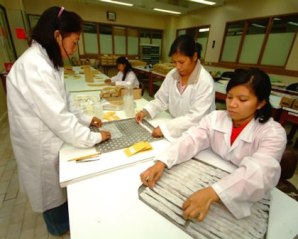Viability of wild rice and related genera genetic resources
Contributors to this page: T.T. Chang Genetic Resources Centre-IRRI, Los Baños, Philippines (Ruaraidh Sackville Hamilton, Ken McNally, Flora de Guzman, Renato Reaño, Soccie Almazan, Adelaida Alcantara, Elizabeth Naredo); WARDA, Cotonou, Benin (Ines Sánchez); UPLB-University of the Philippines at Los Baños (Teresita Borromeo).
|
Contents: |
Laboratory methods
Type of test
- Standard germination test (modified from ISTA methods).
Number of seeds and replicates
- Active and base collections: 20 seeds with 1 or 2 replicates, depending on the amount harvested (some species may not produce enough seeds for storage; some of them may be highly sterile).
Pre-treatment
 Viability is tested initially by placing seeds under conditions conducive to germination and recording the percentage that germinates (photo: IRRI) |
Wild species generally have stronger dormancy than cultivated species and differ widely in response to procedures for breaking dormancy.
- Depending on the species, one or a combination of dormancy-breaking treatments including heat treatment, dehulling, exposure to alternating temperatures and, in some cases, chemical treatment.
- Treat dehulled seeds with fungicide (dehulled seeds are more susceptible to fungal attacks).
Media
- Use Petri dishes lined with moistured paper.
Temperature/ Humidity
- 30oC and 100% RH.
Light
- 12/12 hours light/dark.
Duration of test
- 7-28 days.
Monitoring intervals
- No monitoring should be done during storage (most stocks do not have sufficient stocks for routine monitoring).
- The longevity of wild rice in storage is generally high.
Recording information during viability testing
The following information should be recorded for each testing step:
- Germination date (date of germination).
- No. Tested (number of seed tested).
- % germination rep 1 (germination % in replication 1).
- % germination rep 2 (germination % in replication 2).
- % germination mean (system-calculated mean for the % germination).
- Germination retest (germination % of the retested sample).
- Accession (list of accessions tested).
- Date counted (first count at 7 days and second count at 14 days).
- Normal seedling (seedlings that are free from decay, have well-developed primary root systems, have well-developed and intact coleoptiles).
- Abnormal seedling (seedlings not well developed).
- Assumed dormant seeds (hard but non-germinated seeds).
- Dead seeds (rotten seeds).
- Germination % (the percentage of normal seedlings).
Methods
Minimum viability
- This is not monitored for wild rice due to generally low stocks of seeds.
Minimum quantity
- Each time an accession is removed from storage, for whatever purpose, weigh again and update the computerized inventory before replacing the accession back in storage.
- Use barcoded labels with computerized inventory management system linking the balance to the database.
- If the quantity remaining is less than 60 g, mark the accession in the database as unavailable for distribution and schedule it for regeneration.
Monitoring frequency
This section recommends the minimum quantity and minimum viability of seeds below which they need to be regenerated.
Critical quantity
- 100 grains (twice the amount needed for a regeneration planting).
Critical germination level
- Not applicable for wild rice (dormancy is very hard to break for some spp.).
Recording information during routine monitoring
The following information should be recorded for each step:
- Accession ID (ID of accession).
- Seed Lot ID (ID of this sample of the accession).
- Crop season (year and season the seed was harvested).
- Store – temporary, active bulk, active pre-pack, base, primary safety backup, secondary safety backup (type of storage and packing for this sample).
- Species (the scientific name of the species).
- Germination % (two replications) (germination % - separate values for each replication; new record for each test).
- Germination test No. (number of seed per replicate used for testing germination %).
- Germination date (date of germination test; new record for each test).
- Seed amount units – grams, number of packets (units used to record the amount of seed of this sample).
- Seed amount (amount of seed in store; new record for each update).
- Inventory date (date the amount was last updated; new record for each update).
Note: Health diagnosis (testing) is not recommended during storage of wild rice, due to the usually limited number of seeds in storage.
References and further reading
Naredo MEB, Juliani AB, Lu BR, Guzman F, Jackson MT. 1998. Responses to seed dormancy-breaking treatments in rice species (Oryza L.). Seed Science and Technology 26:675-689.
Comments
- No comments found





Leave your comments
Post comment as a guest